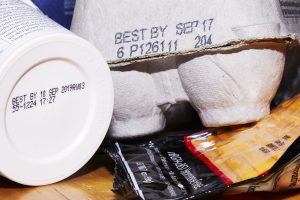Food waste is a big topic these days. A study by the National Resources Defense Council found that a whopping 90% of Americans throw out food before they’re spoiled. Much of that waste is due to confusion over the meaning of dates on food. Those dates are not federally mandated, except on infant formula. The “best by” and “Expiration” dates are not an indicator of freshness or any aspect of food safety. Those dates are just the manufacturers’ suggestions of the time the product is at its best.
So, What Does That Date Mean?
Generally, we think of the expiration dates as a limitation on how long the food is still safe to eat. But that means people may be throwing away food that’s still good, but maybe not as its best. But the more you know about reading food labels, the better protected you will be from either wasting food or making yourself sick.
Food date labels are really more related to the quality of the food, not its actual safety. Then we have to consider all the different terms food companies use and what they mean.
Sell By Date
This is primarily for the retailer to say when the product should be removed from the shelf. This is especially important with fresh foods like meat or dairy products. This doesn’t mean it becomes unsafe to eat after that date. Most stores’ computerized check-outs won’t let you buy expired food, as that date information is linked to the product’s bar code. However, stores also know when things are expiring and often will try to get rid of the items by putting them on sale. Be sure to look at those food labels more closely,. You might not be getting the quality you expect.
Best By Or Best Before Dates
This is the date most often seen on food packaging labels. Again, this is an indication of when the food will be at its best quality or have the best flavor. In no way does that date mean the food has gone bad. So it does not give any clues about the safety of the food.
Guaranteed Fresh Date
Usually, you’ll find this label date on baked goods like bread and pastry. But more and more producers are using freshness as a selling point for other items, like potato chips. This date merely shows how long the food will remain tasty, not how long the food remains good to eat.
Use By Date
This refers to the last date recommended by the manufacturer for the use of the product while at peak quality. The only time this refers to safety is in the case of infant formula. The FDA recommends not eating food that is past this date because it is used mostly for fresh products with a limited shelf life.
Pack Date
Speaking of dates on egg cartons, another date you should know about is the Pack Date or packaging date. This is most commonly found on egg cartons. The pack date is the code that refers to when the product was processed and packaged. This date is usually represented by a three-digit code that translated into the day of the year it was packed. For example, the number 003 would represent January 3rd.
Freeze By Date
You’ll usually see this one on processed meat products, like bacon. In fact, the full text will usually read, “Use or Freeze by.” This shows you how long you can keep the food cold and still be good. Many foods can be frozen for long-term storage after you get home from the store. But to maintain the best taste, you should move the food to the freezer to keep from throwing it away.
When Can You Throw It Away
All your life you’ve probably heard rules or stories about not eating spoiled food. But that doesn’t really mean you know how to tell when food is still good. A lot depends on the type of food and the individual food itself. The rules, therefore, are just general guidelines that will apply on a case-by-case basis.
The Nose Knows
Smell is one of the best senses we have regarding food. Smell is usually much more important than taste in our judgment of good food. Before the food ever gets close to your eating it, take a good sniff. If it doesn’t smell good, it isn’t.
That’s not the only sign of spoilage. Spoilage is the key to the U.S. Food and Drug Association’s definition of using a date on a product label. “If the date passes during home storage, a product could still be safe and wholesome if handled properly until the time spoilage is evident.”
Another sense to use is your eyes. An obvious sign of food going bad is the presence of mold. On cheese and bread, it can be cut away and the rest of the food is good. But it’s a clue that this is the last time you can use it. On meat and vegetables, it’s straight into the trash, nothing else will do. We bachelors are particularly familiar with the fuzzy green thing lurking at the back of the refrigerator.
What? Do you Need More? Okay.
These general food safety guidelines for storing food come from the USDA Food Safety and Inspection Service.
For Refrigerated Foods:
- Ground Meat and Stew Meat: 1-2 days
- Fresh Meat (Beef, Veal, Lamb, and Pork): 3-5 days
- Fresh Poultry: 1-2 days
- Lunch Meat: 2 weeks unopened, 3-5 days open
- Fresh Fish and Shellfish: 1-2 days
- Eggs, fresh in the shell: 3-5 weeks
- Mayonnaise: 2 months
- Milk: 1-2 weeks
Non-refrigerated Foods:
- Rice and dried pasta: 2 years
- High-acid canned foods (such as tomatoes, grapefruit, pineapple): 12-18 months unopened
- Low-acid canned foods (such as meat, poultry, fish, and vegetables): 2-5 years, unopened

The key to all of these rules is SAFE storage. Keeping things at the right temperature, well wrapped (if appropriate) and exposed to as little air as possible. You can stretch that food a bit further by freezing leftovers. Also, remember to use proper thawing and reheating techniques. Seasonal fresh foods, like fruits and vegetables, can be home-canned to enjoy through the cold Winter months.
Even with all these methods of getting the most out of your food, nothing last forever. Even frozen foods have a limited amount of time they can stay in the home freezer without deteriorating.
If you can’t freeze it before it goes bad, make sure your refrigerator is operating at the correct temperature. Remember the Food Danger Zone, temperatures between 40 and 100 degrees Fahrenheit. Food needs to be below or above that zone, and that means cooked or refrigerated.
With all these rules, you would think our food supply should be pretty clean. And it is, compared to most other countries. But you can get hit by a foodborne illness at any time because contamination was not detected in time. Fortunately, in most cases, food poisoning is annoying and will pass through the body in a couple of days. But, if you follow good food safety rules, at least you won’t make yourself or your guests sick.












